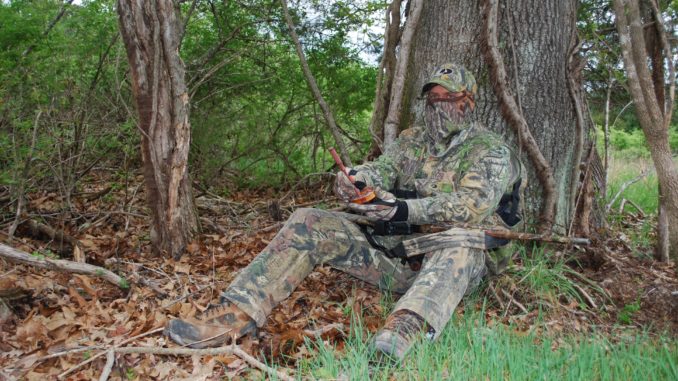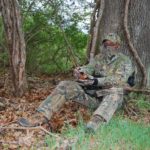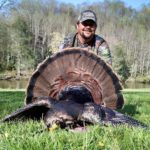
Three top turkey hunters provide their North Carolina brethren with some special tips.
Turkey hunters like to think they know what they’re doing, but is such always the case? To answer that question, as well as five others, a handful of North Carolina’s best turkey hunters spoke on the subject.
• What is one thing that turkey hunters think they’re good at but really aren’t?
Crumpler’s Ben Lucas is a fishing guide for RockOn Charters, associate director of land protection and stewardship for the Blue Ridge Conservancy, and a hardcore turkey hunter. he believes that when hunters pursue a tom several days in a row, they think they’re coming closer to killing him, but often the opposite is true.
“Too many hunters approach a tom every morning from the same direction, set up in the same place, make the same sounds with the same calls, then leave from the same direction they came,” he said. “In reality, their odds are decreasing every day. Every day you go after a gobbler, come at him from a different direction and mix up your callers and your calls.
Greg Longuillo, who operates L&L Turkey Calls in Trinity, believes hunters think they know how to walk quietly through the woods, but many definitely don’t.
“Most hunters don’t walk slowly enough, or don’t pick up their feet, or they break sticks when they walk,” he said. “If two people are walking together in the woods, one needs to walk right behind the other, and both need to step lightly and slowly along or they might spook turkeys without evening knowing the birds were there.”
Reidsville’s Kimmy Hanks operates Hanks Game Calls; he said many hunters don’t conceal themselves well.
“So many times I’ve spotted hunters sitting along field edges totally exposed,” he said. “You can’t beat a leafy suit for concealment.”
•What is the absolute best tip you have for other hunters?
Lucas’ best tip has little to do with hunting, but, in reality, it has everything to do with our pastime. Lucas maintains that on land sportsmen own, lease or hunt, they should endeavor to improve the habitat.
“We hunters can do so much more to improve wildlife habitat for everything from deer and turkeys to small mammals and songbirds,” he said. “For example, a clearcut can provide nesting areas for turkeys and fawning areas for deer; a timber stand improvement project can result in more hard and soft mast production, and protecting mature hardwoods in a riparian zone can lead to having a great roost site and improve water quality for gamefish as well.”
Lucas adds that hunters should contact landowners from whom they lease land or whose land they have permission to hunt and discuss these and other projects. He said that one of the best landowner/sportsmen he has worked with is Alleghany County’s Tom Smith who has initiated a number of projects.
Longuillo believes that if turkey hunters would just tone down their calling, they would kill more longbeards.
“Take your time and don’t overcall,” he said. “Don’t call just to hear the turkey gobble, and don’t call every time he gobbles and don’t call birds in before the season starts.”
Hanks says to be patient and persistent.
“If a tom has hens and you can’t call the hen to you, pattern him,” he said. “Get in his travel lane. If you over call, hens will take him away 90 percent of the time.”
• What’s the best tip you’ve ever received?
When he was very young, Lucas was told to be more patient. He didn’t pay heed until many seasons later. So many times over those lost years, Lucas would arise from a setup after a few calls and spook birds. Finally he took advantage of the old gentleman’s advice.
“For example, a couple of years ago, a friend and I were hunting at the bottom of an Ashe County mountain when we heard two gobblers well above us,” said Lucas. “I’ve always heard that gobblers can’t be called downhill, but there was really no way for my buddy and me to approach those gobblers without being seen.
“So we decided to call softly and infrequently and committed to sitting still. About an hour later, the two gobblers started moseying down the mountain, and I shot the first one that came within range. That bird was killed because we were patient.”
Longuillo has a similar old man in his history who also touted the virtues of patience.
“One particular time when patience paid off was when I knew the toms were henned up, and it was going to take some work to get them away from the hens,” he said. “I’d been working the birds since daylight and knew they weren’t coming any closer. Around 9, I did some loud yelping and heavy cutting on my scratch box. I thought that waiting a while was my best strategy, so I settled in and took a nap for about an hour.
“I woke up about 10 am, and clucked twice on my scratch box. A tom hammered back. I waited a couple minutes and clucked again. I could tell he’d already cut the distance by half. After one more set of clucks, I put the call down and got my gun in position. Within 10 minutes, I had a clean shot and took him out.”
Hanks said a Reidsville sportsman taught him to call sparingly, especially on pressured birds.
“The late David Madison of Reidsville told me to make a couple yelps, and if a gobbler answered, throw the call as far as you can throw it,” he said. “This was more than 20 years ago; I have to remind myself what he told me a lot of mornings.”
• What sound, beyond basic clucks and yelps, should turkey hunters make more often?
Lucas said his choice would be the fly-down cackle; he describes it as “a sound that everyone knows, but few people make.” Follow that sound up with light clucks, he said. For an underutilized call, Longuillo opts for purring with his scratch box.
“Once you learn to play this call by using different angles on the striker, it will produce both the clean notes of a young hen or raspy old hen notes,” he said. “I use purring, soft calling and scratching in the leaves for high-pressured birds on public land. These birds have heard a lot of aggressive calling. In the woods, hens don’t call aggressively very often, so soft purrs and scratching in the leaves are more natural sounds.
Longuillo said this technique works best with a two-man setup, with a shooter and a caller who is more concealed and who can call without being detected.
Hanks agrees with Longuillo about scratching in the leaves.
“I’ve killed many gobblers by scratching after using my hat to make fly-down sounds,” he said. “Some birds I’ve never made a call to, just scratched in leaves. In my opinion, that’s the best thing you can do when you’re close to a gobbler on the roost.”
• Did you ever experience an eureka moment that changed the way you hunt turkeys?
Lucas said his eureka moment involved revisiting a hunting strategy that has largely gone out of fashion: roosting a gobbler for the next day’s hunt. He’d been told that the gambit was something only old men still practiced. When Lucas roosted a tom he’d hunted unsuccessfully over several days, he got very close to the bird on the roost the next morning, and then called in and killed him. That was his epiphany.
For Longuillo, his eureka moment came when he realized it was folly to use turkey calls to locate longbeards.
“Once while hunting with my father, we stopped on the side of the road by a field in order to locate a bird,” he said. “Instead of using a locator call, I cackled loudly on a box call and got an immediate response. By the time my father and I got our guns, put on our vests, and trekked halfway across the field, we came face to face with the tom. We got busted that fast. The problem with using a turkey call to locate birds is that they can bust you before you set up.”
Hanks said he was skeptical about using a turkey fan until three years ago.
“I had a gobbler with multiple hens who wouldn’t budge,” he said. “I then held a fan out over a ridge. The gobbler came running full speed with his head down, and I smoked him. I’ve found a fan works best on dominant birds and seems to do better when they have hens.”
• What caller, beyond the basic box, pot and peg and diaphragm, would turkey hunters be well advised to learn how to use more effectively?
Lucas said that a pileated woodpecker call has the potential to produce a reaction. Longuillo utilizes a call that hunters rarely employ.
“On one Caswell County hunt, I used nothing but my tube call to cluck to a high-pressured tom,” he said. “Because of the tube’s more natural sound, I think this was the difference in why the gobbler charged in so quickly. I was headed back to the truck by 6:35 a.m.”
Hanks agrees about the effectiveness of locator calls.
“So many times I’ve cut to see if I could get a gobbler to respond, and he gobbles on top of me before I can set up,” he said. “Here in North Carolina, we’ve a lot of geese, woodpeckers and crows. Gobblers have responded to all three for me.”
Not as successful the past few seasons as you’d like? Consider these tips for this spring.





Be the first to comment